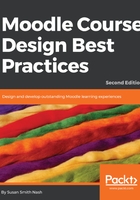
Selecting resources and activities
Let's return to our course. Now that you can write effective learning outcomes and have used them to build your course framework, which is structured around topics, let's return to adding resources and activities and let's look at matching learning activities with resources and activities.
Let's return to Topic 1: New Definitions of Tourism. Let's say that we want to start by adding content that helps define tourism. What might that include? Here are our options from the pull-down menu that says Add a resource. Note that there is another pull-down menu next to it that says Add an activity. Keep in mind that we are using the Boost theme and that there may be slight variations with other themes:

So, we could choose to add a file which consists of an article with examples of tourism. Or we could create a folder and fill it with different articles and maps. Another useful item is a Page, in which we can write definitions, plus include links to outside videos, audio files, maps, images, and texts.
Now, let's say that we'd like the learner to collaborate with other learners, or to do something interactive that allows them to apply their knowledge. That's where Add an activity comes into play. Moodle has a nice selection of prepackaged activities that range from collaboration-engendering discussion forums, workshops, and webinars, to engaging "check your knowledge" activities, such as choice, and a quiz:

When you add each element, make sure that it directly connects to your learning outcome and that you explain how those connections are made. Also, this is a good time to remind yourself of the UDL and how best to meet the needs of students with a wide range of skills and abilities.